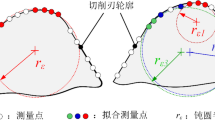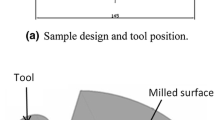Abstract
Milling is a machining method used extensively nowadays in the manufacturing industry. In the milling process, one of the most important parameters affecting the machining performance is cutting tool geometry. In general, the effects of helix and rake angles, which are among the most important geometric parameters, on tool performance, are significant. In this study, the cutting force performance of wave form end mills that have a limited investigation both in the industry and academia is analyzed. The essential geometric factors in wave form end mills are designed with variable helix and rake angle along the helical cutting edges. In this work, the cutting force performance was experimentally and numerically compared with wave form tools, which are designed for reducing cutting forces and standard tools in terms of cutting forces on gray cast iron (GG25) according to ISO 8688-2 standard. The experimental results showed that an increase in the cutting force performance of wave form tools up to 11.4% compared to standard tools. Wave form tools with different geometric forms were compared with the validated finite element method (FEM) simulations based on experimental studies. As a result of FEM analysis, lower cutting forces (14.42%, 11.45%, 8.49%) obtained by 8–0.250, 6–0.450, 8–0.350 (wavelength-wave amplitude, mm) wave form tools compared to the standard tool. In addition, increment in cutting forces (− 6.37%, − 6.06%, − 5.92%) obtained by 8–0.150, 4–0.350, 8–0.650 tools.








Similar content being viewed by others
References
Abukhshim, N.; Mativenga, P.; Sheikh, M.A.: Heat generation and temperature prediction in metal cutting: a review and implications for high speed machining. Int. J. Mach. Tools Manuf. 46(7–8), 782–800 (2006)
Altıntaş, Y.: Manufacturing Automation: Metal Cutting Mechanics, Machine Tool Vibrations, and CNC Design. Cambridge University Press, New York (2012)
Dombovari, Z.; Stepan, G.: The effect of harmonic helix angle variation on milling stability. In: ASME 2011 International Design Engineering Technical Conferences and Computers and Information in Engineering Conference. American Society of Mechanical Engineers, pp. 467–473. (2011)
Burek, J.; Zylka, L.; Plodzien, M.; Gdula, M.; Sulkowicz, P.: The influence of the cutting edge shape on high performance cutting. Aircr. Eng. Aerosp. Technol. (2018)
Okafor, A.C.; Sultan, A.A.: Development of a mechanistic cutting force model for wavy-edge bull-nose helical end-milling of inconel 718 under emulsion cooling strategy. Appl. Math. Model. 40(4), 2637–2660 (2016)
Dombovari, Z.; Stepan, G.: The effect of helix angle variation on milling stability. J. Manuf. Sci. Eng. 134(5), 051015 (2012)
Korovin, G.; Petrushin, S.; Gubaidulina, R.: Machining of titanium alloys with wave milling cutters. In: Materials Science Forum, pp. 79–85. Trans Tech Publications Ltd, Switzerland (2018)
Song, Q.; Ai, X.; Zhao, J.: Design for variable pitch end mills with high milling stability. Int. J. Adv. Manuf. Technol. 55(9–12), 891–903 (2011)
Wan, M.; Feng, J.; Zhang, W.-H.; Yang, Y.; Ma, Y.-C.: Working mechanism of helix angle on peak cutting forces together with its design theory for peripheral milling tools. J. Mater. Process. Technol. 249, 570–580 (2017)
Maurel-Pantel, A.; Fontaine, M.; Thibaud, S.; Gelin, J.-C.: 3D FEM simulations of shoulder milling operations on a 304L stainless steel. Simul. Model. Pract. Theory 22, 13–27 (2012)
Wu, H.; Zhang, S.: 3D FEM simulation of milling process for titanium alloy Ti6Al4V. Int. J. Adv. Manuf. Technol. 71(5–8), 1319–1326 (2014)
Rao, B.; Dandekar, C.R.; Shin, Y.C.: An experimental and numerical study on the face milling of Ti–6Al–4V alloy: tool performance and surface integrity. J. Mater. Process. Technol. 211(2), 294–304 (2011)
Hanson, C.; Hiwase, P.; Chen, X.; Jahan, M.; Ma, J.; Arbuckle, G.: Experimental investigation and numerical simulation of burr formation in micro-milling of polycarbonates. Procedia Manuf. 34, 293–304 (2019)
Chagas, G.; Machado, I.: Numerical model of machining considering the effect of MnS inclusions in an austenitic stainless steel. Procedia CIRP 31, 533–538 (2015)
Zhou, L.; Peng, F.; Yan, R.; Dong, Q.; Yang, C.: Prediction and experimental validation of micro end-milling forces with finite element method. In: International Conference on Intelligent Robotics and Applications, pp. 664–675. Springer, New York (2015)
Mohammed, W.M.; Ng, E.; Elbestawi, M.: Modeling the effect of the microstructure of compacted graphite iron on chip formation. Int. J. Mach. Tools Manuf. 51(10–11), 753–765 (2011)
Chagas, G.M.P.; Seriacopi, V.; Machado, I.F.: Numerical machining simulation for an Aisi 304 stainless steel considering microfracture mechanics aspects. In: Paper presented at the 22nd International Congress of Mechanical Engineering, (2013)
Bosetti, P.; Maximiliano Giorgio Bort, C.; Bruschi, S.: Identification of johnson–cook and tresca's parameters for numerical modeling of aisi-304 machining processes. J. Manuf. Sci. Eng. 135(5) (2013)
Shaw, M.C.; Cookson, J.: Metal Cutting Principles, Vol. 2. Oxford University Press, New York (2005)
ISO 8688–2: Tool Life Testing in Milling - Part 2: End Milling. International Standards Institution, Switzerland (2006)
Aydın, K., Akgün, A., Yılmaz, B., Yavaş, Ç., Şeker, U. (2019) Investigation of the machining performance of the wavy form end mill with variable rake angle. In: Paper presented at the 10th International Congress on Machining, Antalya/Turkey
Karcan Cutting Tools. http://www.karcan.com/en/product/100-series-endmill. Accessed 27 Feb 2021
Shrot, A.; Bäker, M.: Determination of Johnson–Cook parameters from machining simulations. Comput. Mater. Sci. 52(1), 298–304 (2012)
AdvantEdge 7.1 User’s Manual, Third Wave Systems (2015)
Chen, M.; Jiang, L.; Guo, G.; An, Q.: Experimental and FEM study of coated and uncoated tools used for dry milling of compacted graphite cast iron. Trans. Tianjin Univ. 17(4), 235–241 (2011)
Grzesik, W.; Rech, J.; Żak, K.; Claudin, C.: Machining performance of pearlitic–ferritic nodular cast iron with coated carbide and silicon nitride ceramic tools. Int. J. Mach. Tools Manuf 49(2), 125–133 (2009)
Malakizadi, A.; Sadik, I.; Nyborg, L.: Wear mechanism of CBN inserts during machining of bimetal aluminum-grey cast iron engine block. Procedia CIRP 8, 188–193 (2013)
Dandekar, C.R.; Shin, Y.C.; Barnes, J.: Machinability improvement of titanium alloy (Ti–6Al–4V) via LAM and hybrid machining. Int. J. Mach. Tools Manuf 50(2), 174–182 (2010)
Gao, G.; Wu, B.; Zhang, D.; Luo, M.: Mechanistic identification of cutting force coefficients in bull-nose milling process. Chin. J. Aeronaut. 26(3), 823–830 (2013)
Mamedov, A.; Lazoglu, I.: Machining forces and tool deflections in micro milling. Procedia Cirp 8, 147–151 (2013)
Acknowledgements
The authors wish to gratefully acknowledge Karcan Cutting Tools for supporting the study. The authors wish to gratefully acknowledge TÜBİTAK with 119M657 numbered 1002—Short Term R&D Funding Program for funding the study.
Author information
Authors and Affiliations
Corresponding author
Rights and permissions
About this article
Cite this article
Aydın, K., Akgün, A., Yavaş, Ç. et al. Experimental and Numerical Study of Cutting Force Performance of Wave Form End Mills on Gray Cast Iron. Arab J Sci Eng 46, 12299–12307 (2021). https://doi.org/10.1007/s13369-021-05816-z
Received:
Accepted:
Published:
Issue Date:
DOI: https://doi.org/10.1007/s13369-021-05816-z




